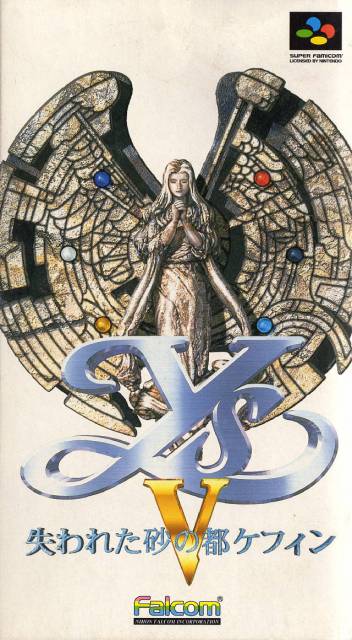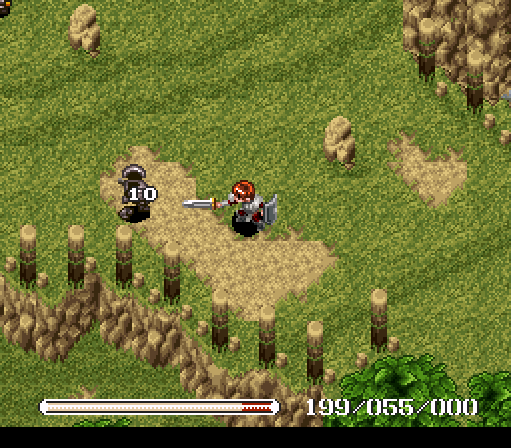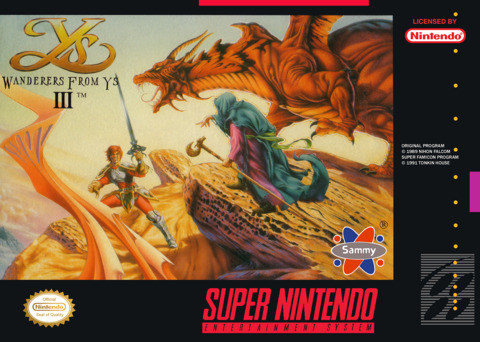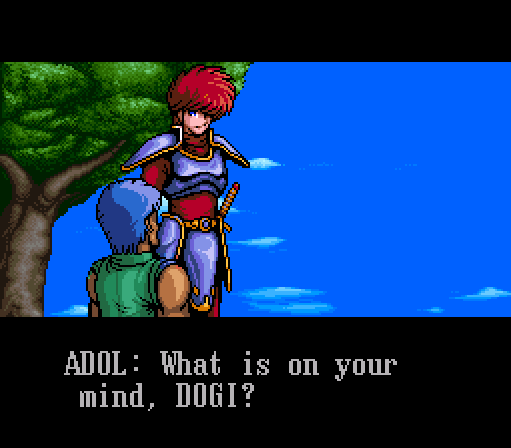The SNES Classic Mk. II: Episode XVI: Too Easy
By Mento 1 Comments
The SNES Classic had a sterling assortment of games from Nintendo's 16-bit star console, but it's hardly all that system has to offer a modern audience. In each installment of this fortnightly feature, I judge two games for their suitability for a Classic successor based on four criteria, with the ultimate goal of assembling another collection of 25 SNES games that not only shine as brightly as those in the first SNES Classic, but have equally stood the test of time. The rules, list of games considered so far, and links to previous episodes can all be found at The SNES Classic Mk II Intro and Contents.
Episode XVI: Too Easy
The Candidate: Nihon Falcom's Ys V: Ushinawareta Suna no Miyako Kefin

Ys V: Ushinawareta Suna no Miyako Kefin, or Ys V: Kefin, The Lost City of Sand, is the fifth game in Falcom's Ys series of action-RPGs featuring Adol Christin, a.k.a. Adol the Red, and so far is the only one that has never been officially localized. Aeon Genesis, busy folks that they are, have since fan translated the game at least, allowing western audiences to finally get a glimpse of this "missing" Ys game. (Meanwhile the other unofficially localized SFC Ys game, Ys IV: Mask of the Sun, was later remade as Ys: Memories of Celceta and released globally for PlayStation Vita and more recently on Steam.)
The chronology of the Ys series has always been a little wild. Ys V is actually set between Ys III: The Wanderers from Ys (or, if you prefer, its remake Ys: The Oath in Felghana) and the recently released Ys VIII: Lacrimosa of Dana (in a cute touch, the ultimate equipment of Ys V - the Isios set - is what Adol is wielding in Ys VIII's prologue before he loses it all in the inevitable shipwreck). The chronology is largely immaterial however, as each game is a standalone adventure of Adol in various parts of a fictional version of Europe and Africa. Specifically, Ys V is set in "Xandria": a stand-in for the Egyptian port city of Alexandria. Likewise, the game's story concerns an ancient civilization named Kefin that vanished several hundred years ago - not unlike the titular Ys of the first two games - and the detrimental environmental affects the ancient city's use of alchemy is continuing to have on the present day region. Adol offers to help recover six elemental crystals that should thwart the collapse, though naturally his quest isn't going to be as straightforward as that.
It's remarkable how familiar a lot of Ys V feels. Ys has always operated on a formula of sorts, but playing Ys VIII and Ys V only months apart has affirmed just how set in its ways the series has always been, despite the fact there's twenty-two years and four console generations between the two games. The real-time combat is as swift and potentially deadly as ever, a lot of recurring leitmotifs are present in both like the Metroid-like jingle that plays when Adol receives a valuable item, health regeneration but only outdoors and when Adol is standing still, and there's a certain amount of low-key grinding the game expects you to make to be properly prepared for the bosses to come. Actually, if Ys V suffers in comparison to its brothers, it's in how underwhelming a lot of its boss fights are: due to an abundance of healing items and the always-effective attack spamming, most tend to go down pretty quick with little incurring damage. It's probably why Falcom felt the need to commission a remaster the following year that amped up the difficulty, dubbed Ys V: Expert. (This practice wasn't unique to this game either; Koei's Brandish II saw its own SFC Expert version released around the same time. Meanwhile, Final Fantasy IV actually went the other direction, releasing an "Easy Type" edition a few months after the original that would become the basis of the "Final Fantasy II" North American localization.)
Ys V's combat pulls off the impressive contradiction of being both too simple and overly complex, due to the way the game distinguishes Adol's sword combat - which couldn't be easier than swinging a sword with an attack button when enemies get close, A Link to the Past style - and the game's magic system, in which alchemist vendors will create magic spells by combining three elemental gems. There's a huge variety of spells to choose from, but you don't get any sense of their effects until after you've crafted the "fluxstone", as these spell stones are called, and equipped them. To use one, you have to charge up a gauge to 100% with the R button and let loose. Some have far better utility than others, but unless you save before trying out the combinations of elements and Fluxstones you have available, it's possible to end up with a lemon that takes half a minute to cast instead of something you can actually use in a pinch. Oddly, the game has two separate XP bars for your physical and magical combat respectively: destroying an enemy with your sword adds to the former and provides more HP upon level up, while destroying an enemy with magic adds to the latter and instead grants more MP. I never used the magic much myself but there are definitely monsters that are better fought at a distance, especially those able to grab you.

As is often the nature of "lost" games in JRPG franchises that remained trapped behind the language barrier for a lengthy time, such as Tales of Innocence or Final Fantasy V, they're usually more average and unremarkable than the illusion that our minds create of being these forgotten gems kept hidden away for far too long. Ys V isn't anything too special by Ys standards, though it's hardly a slouch either, and there's a number of ideas and concepts that feel a little underbaked and never appeared again in the series. In comparison, 2003's Ys VI: The Ark of Napishtim was a huge shot in the arm for the franchise, establishing a whole new paradigm - more game speed, more frantic rock music, an emphasis on difficult boss fights that required some memorization of patterns to effectively conquer - that has continued to define the Ys experience ever since.
In terms of Ys games, it's merely adequate. However, how does it compare to the rest of the SNES library? Well, we'll need to get our friend P.O.G.S. in to determine that:
- Preservation: The Ys games remain evergreen despite the evident age of some of the earlier entries due to two factors - their agreeable length, usually around 8-10 hours each (well, until you get to the newer ones), and the action combat which can still offer a challenge and requires strategic consideration, but is simple to master and moves at a clip. Ys V's story is pretty decent for a SNES game, offering lots of twists and surprises, though it probably won't be too shocking to anyone who's played a more recent Ys entry. I also think the game's pixel art holds up well, though some areas look better than others and most of the top-down character sprites end up largely interchangeable. 4.
- Originality: Ys V doesn't really innovate a whole lot beyond what had already come before in Ys III and IV. It combines the "attack button" combat engine of III (rather than the "run at enemies at an adjacent angle" that Ys I, II and IV had) and the fixed top-down view of Ys IV to create a best of both worlds variant that later Ys games would stick to until the series went fully 3D with Ys VIII. Its plot of Adol showing up somewhere new on a boat and saving everyone from some ancient city's sorcery gone awry is deliberately old hat - like Zelda and Mario, the Ys series doesn't deviate from what works as a framing story - and the few actual innovations like the magic system feel a little off. 3.
- Gameplay: Well, it's an Ys game, so the gameplay is top-notch for the most part. There are few SNES RPGs that control as quickly or as concisely as this game, though there are a handful of irritating platforming puzzles that might deter those who aren't adept at them. Ys V might be a little too compact for its own good at times also; most of the dungeons are incredibly short, usually around a dozen screens each, and the aforementioned boss fights can be underwhelming and easy compared to other games in the franchise as the immense foes just kind of hover around waiting to get hit. There's some iffy collision too, where closing the distance to hit enemies will likely hurt you also; I'm guessing the game's intent here was for you to rely on your ranged magic more. That familiar and welcoming Ys action-RPG groove is still here though, and it's hard to fault it. 4.
- Style: Graphically the game is fine if nothing special, and likewise the music is a little lacking compared to Ys III and the more rock-infused later entries, but it does have some neat monster designs and displays some visual variety with its dungeons. A nice touch is letting players customize the color of Adol's armor and clothes (there's also a secret NPC that turns Adol's hair from a strawberry blond to the vivid crimson he's known for, which is an odd inclusion). The Aeon Genesis localization is great too, with only a handful of typos. I'll give some credit here to the game's story also, which is better told than most RPGs for the system if a little prone to clichés. 4.
Total: 15.
Other Images:
The Nominee: Nihon Falcom/Advance Communication's Ys III: Wanderers From Ys

Ys V was the final Ys game to grace the SNES, and Ys III was the first. The game takes on a 2D perspective more akin to Falcom's Dragon Slayer series, perhaps for the sake of bridging two of their most successful franchises. It also introduces for the first time a more logical and straightforward combat system, where the player has to initiate a sword strike with an attack button in order to damage foes, rather than running at them at the correct angle. In some respects Ys III is, like Zelda II (another side-scrolling aberration), the black sheep of its particular franchise. However, I'd also argue that Ys III performed what it set out to do admirably and became the basis for most of the Ys games to follow.
Ys III sees Adol and his frequent companion Dogi return to Redmont, Dogi's hometown. It just so happens that there's trouble afoot, as the town's citizens have come under attack by beasts on the roads more frequently and the despotic local ruler holed up in Valestein Castle continues to do nothing but raise taxes. Most pressing is the monster outbreak in the mines, which Redmont depends upon for its revenue, which Adol immediately volunteers to investigate. Ys III's plot relies a lot on escalation, where completing one goal triggers an unrelated objective elsewhere, bouncing Adol between various story quests that eventually culminates in a showdown with the culprit behind all the town's suffering.
Like Ys V, Ys III's appeal is in the compactness of the experience and the alacrity of its combat. You may have to grind occasionally (or a lot) to survive the next dungeon or its boss, but the game moves so fast that it's likely to only take a few minutes of clobbering enemies near the entrance at most to reach a survivable level. This approach has always lent the Ys games a sort of arcade feel, one that actually prioritizes the playing of the game rather than the preparation and tactics surrounding it that are more the focus in its turn-based peers. It lacks a lot of the refinements of Ys V and the more modern entries, and a really obnoxious opening few hours as you grind until you can survive the first dungeon, but it's feisty and scrappy in the way Ys fans have come to expect and appreciate. The one thing I will say that kinda hurts Ys III is that Ys: The Oath in Felghana is an objectively better game by every metric, rendering the original Wanderers from Ys obsolete in my view.

It's time to cast the Slammer of Destiny and see what the P.O.G.S. have to say about this:
- Preservation: I would argue that Ys III has aged a little worse than Ys V, largely because it takes so long to get going and there's a lack of a safety net by way of frequent saving opportunities. I'd also argue that Ys V's top-down nature is easier to come back to if you're a series veteran - the side-scrolling's fine, but it lacks that extra dimension to maneuver in. The graphics take a bit of a hit in comparison also, though I kinda like the cute little sprites. 3.
- Originality: Unlike Ys V, which was largely built on what had come before, Ys III struck out on its own with a new perspective and combat system. It still retains the story progression, levelling, and equipment systems of Ys I & II, but that attack button aspect proved far more appealing than the unsurprisingly hazardous and unpredictable method of running into enemies to hurt them. Ys III can be seen as more of a building block to the series' greater successes down the road rather than something that stands on its own as a high point - more a cocoon than a butterfly. 4.
- Gameplay: The aforementioned difficulties with the game, most of which were mitigated by subsequent entries, really hurts it early on. As does the notorious "lava zone", which is an incredibly tough dungeon that Adol is unceremoniously dropkicked into with no other means of leaving except reaching its end. It doesn't feel like it surfaces a lot of information about equipment either - there's no in-game indication of whether a new sword is better than the old one, besides the fact that it's placed further along on the inventory screen. As previously stated, Ys III feels it's aged more than Ys V, and that's not just because of the four years that separates them (six, if we go by Ys III's original PC-8801 release). 3.
- Style: What Ys III lacks graphically compared to Ys V it more than makes up for with its fantastic soundtrack, which - again, a recurring issue for this game in particular - is one-upped by the PC Engine port with its CD audio and again by the 2005 remake. Unforgettable themes like The Boy's Got Wings, Illburn Ruins, Beasts as Black as Night, Shock of the Death God, and Valestein-mothereffing-Castle - though I've listened to them all to death as part of The Oath in Felghana soundtrack, they're all recognizable here too. 4.
Total: 14.
Other Images:












